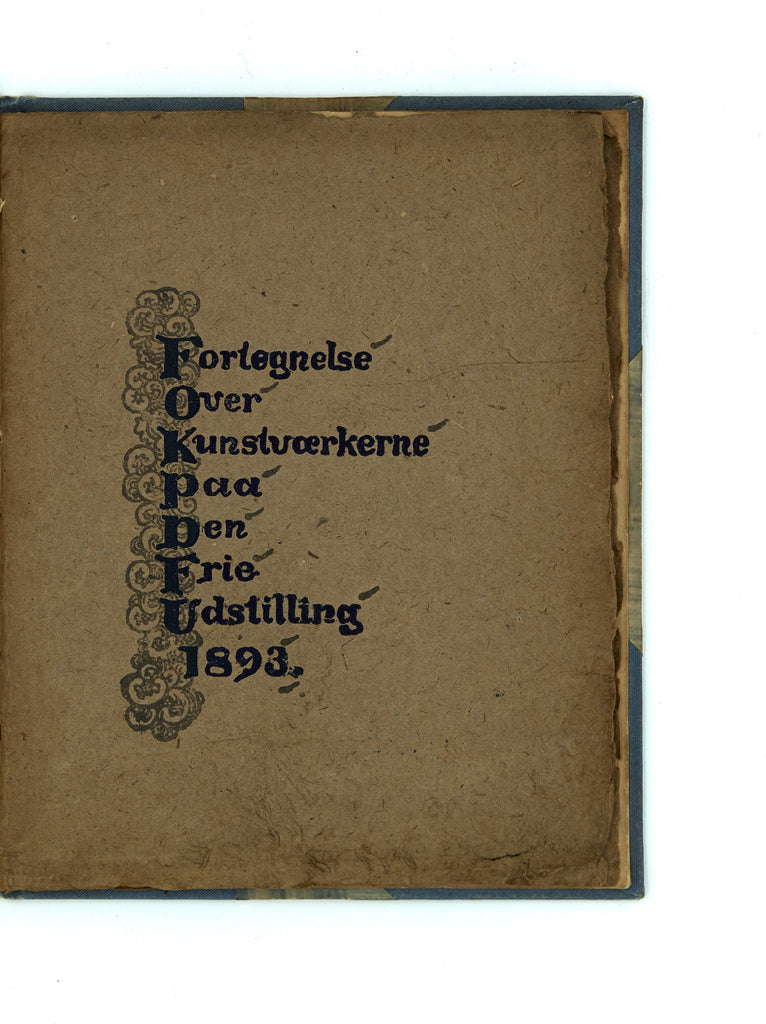Fortegnelse Over Kunstvaerkerne Paa Den Frie Udstilling 1893
Den Frie Udstilling


Kjobenhav [Copenhagen]: J.Jorgensen & Co.. 1893.
A catalogue of the first exhibition of paintings by Van Gogh in Denmark. 170x135mm. Text block 155x125mm. Unpaginated. 36pp. In original grey paper wrappers, with title, date and floral decoration on the front cover. Bound into blue half cloth and decorated paper covered boards. Some slight rubbing to the boards but the catalogue itself and its delicate wrappers are in excellent condition. Rare, Worldcat locating only two copies, one in Denmark and the other in the Metropolitan Museum in New York.
This modest little booklet listing the works of art displayed at Den Frie Udstilling in 1893, captures an important moment in European art: it records the public bringing together of the work of Gauguin and Van Gogh and it also marks a crucial step in the establishment of the reputation of Van Gogh. Den Frie Udstilling (The Free Exhibition) was founded in 1891 as a protest against the narrow and conservative admission policy of the Kunsthal Charlottenborg gallery of the Royal Danish Academy of Art. Taking as its inspiration the Impressionists' Salon des Refusés, Den Frie Udstilling was founded by the painter, printer and designer Johan Rohde, an early champion of Van Gogh whose work he collected. The first exhibition was dominated by Danish artists including Vilhlem Hammershoi, Harald and Agnes Slott-Moller and Rodhe himself. In 1893, Den Frie Udstilling moved to a specially designed wooden pavilion in the centre of Copenhagen and exhibited forty-nine paintings by Paul Gauguin and twenty-eight works by Van Gogh including two of his Sunflowers, a Self-Portrait, a study of a crab, a drawing of the garden of the hospital at Arles and the beautiful White Orchard. Of Gauguin's works, fewer than half date from, or from before, his short, disastrous stay in Copenhagen in 1884-85 when he moved there to join his Danish wife. Clearly the regard in which Gauguin was held by Danish artists survived his difficult Copenhagen period.
Van Gogh and Gauguin were, of course, close friends, living together in Arles for a few months at the end of 1888 before the relationship soured. Immediately after Van Gogh's death in 1890, his brother Theo ensured that exhibitions of Vincent's work were staged as widely as possible. With Theo's death in 1891, it seemed that Van Gogh's reputation might fade. Certainly Gauguin did little to assist, so one wonders what he might have felt at co-staring in this 1893 Copenhagen show. It was only through a handful of exhibitions in the 1890s such as this one at Den Frie Udstilling that Van Gogh's position in the canon became secure.
A catalogue of the first exhibition of paintings by Van Gogh in Denmark. 170x135mm. Text block 155x125mm. Unpaginated. 36pp. In original grey paper wrappers, with title, date and floral decoration on the front cover. Bound into blue half cloth and decorated paper covered boards. Some slight rubbing to the boards but the catalogue itself and its delicate wrappers are in excellent condition. Rare, Worldcat locating only two copies, one in Denmark and the other in the Metropolitan Museum in New York.
This modest little booklet listing the works of art displayed at Den Frie Udstilling in 1893, captures an important moment in European art: it records the public bringing together of the work of Gauguin and Van Gogh and it also marks a crucial step in the establishment of the reputation of Van Gogh. Den Frie Udstilling (The Free Exhibition) was founded in 1891 as a protest against the narrow and conservative admission policy of the Kunsthal Charlottenborg gallery of the Royal Danish Academy of Art. Taking as its inspiration the Impressionists' Salon des Refusés, Den Frie Udstilling was founded by the painter, printer and designer Johan Rohde, an early champion of Van Gogh whose work he collected. The first exhibition was dominated by Danish artists including Vilhlem Hammershoi, Harald and Agnes Slott-Moller and Rodhe himself. In 1893, Den Frie Udstilling moved to a specially designed wooden pavilion in the centre of Copenhagen and exhibited forty-nine paintings by Paul Gauguin and twenty-eight works by Van Gogh including two of his Sunflowers, a Self-Portrait, a study of a crab, a drawing of the garden of the hospital at Arles and the beautiful White Orchard. Of Gauguin's works, fewer than half date from, or from before, his short, disastrous stay in Copenhagen in 1884-85 when he moved there to join his Danish wife. Clearly the regard in which Gauguin was held by Danish artists survived his difficult Copenhagen period.
Van Gogh and Gauguin were, of course, close friends, living together in Arles for a few months at the end of 1888 before the relationship soured. Immediately after Van Gogh's death in 1890, his brother Theo ensured that exhibitions of Vincent's work were staged as widely as possible. With Theo's death in 1891, it seemed that Van Gogh's reputation might fade. Certainly Gauguin did little to assist, so one wonders what he might have felt at co-staring in this 1893 Copenhagen show. It was only through a handful of exhibitions in the 1890s such as this one at Den Frie Udstilling that Van Gogh's position in the canon became secure.
